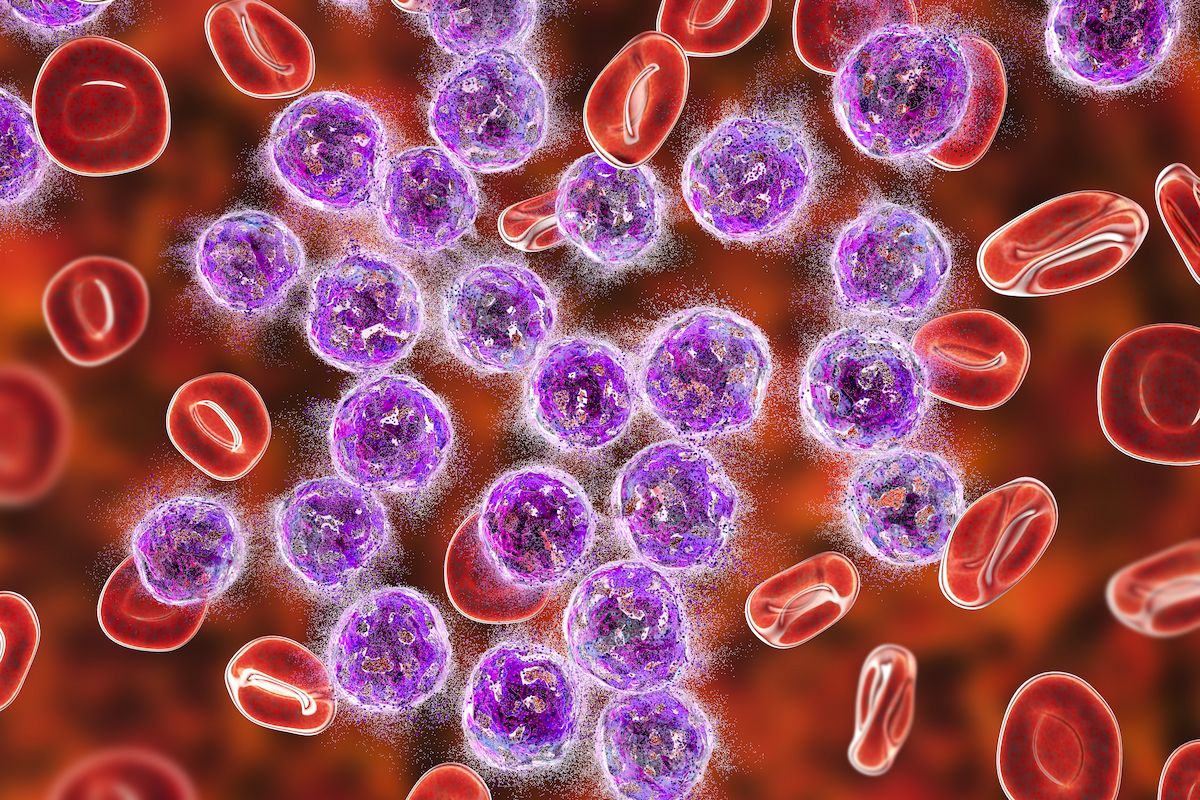Efficacy Demonstrated Using Olverembatinib in Chronic-Phase CML
Olverembatinib appears effective in patients with CP-CML without T315I mutations following prior first-line tyrosine kinase inhibitor therapy.
“Olverembatinib demonstrated remarkable efficacy in patients with CP-CML, without T315I mutations who [were] resistant or intolerant to prior first-line TKI treatment, and especially of the patients who experienced failure on first-line second-generation TKI treatment, and of those who harbored BCR-ABL mutations other than T315I, and no new safety signals emerged with olverembatinib treatment as compared with those previously reported," according to study author Li Weiming, MD.

Efficacy and safety were reported among patients with chronic myeloid leukemia in chronic phase (CP-CML), especially among those with prior tyrosine kinase inhibitor (TKI) therapy, who received olverembatinib, according to data from the single-arm, multicenter, open-label ChiCTR2200061655 study were presented at the 2024 American Society of Hematology Annual Meeting & Exposition (ASH).
“This is the first report of olverembatinib as a second line TKI therapy in patients with CML,” said Li Weiming, MD, of the Department of Hematology, Union Hospital, Tongji Medical College, Huazhong University of Science and Technology in Wuhan, China, in a presentation of the data at the conference. “Olverembatinib demonstrated remarkable efficacy in patients with CP-CML, without T315I mutations who [were] resistant or intolerant to prior first-line TKI treatment, and especially of the patients who experienced failure on first-line second-generation TKI treatment, and of those who harbored BCR-ABL mutations other than T315I, and no new safety signals emerged with olverembatinib treatment as compared with those previously reported.”
This preliminary data, he said, “suggests that olverembatinib may be a viable second-line treatment option for patients with CP-CML, especially for those who experience failure on first-line, second-generation TKIs.”
Researchers reported that while the third-generation BCR-ABL1 TKIs had previously been shown to be safe and effective among patients with CML who were either resistant or intolerant to two prior TKIs or those who had the T315I mutation, the current study intended to evaluate the treatment in the second line among patients without the T315I mutation.
The study enrolled 43 patients with CP-CML, 93.9% of whom were first line TKI-resistant and 6.9% of whom were first line TKI-intolerant. Participants’ median age was 45.0 (19-70) years, and 69.8% of patients were male.
Regarding best responses, as of a data cutoff of Nov. 15, 2024, 33 patients had undergone at least 1 efficacy assessment, 28 (66.7%) had at least 2, and 23 (54.8%) had at least 3. By the cutoff date, at a median follow-up of 16.0 (2-18) months, among efficacy-evaluable patients 74.1% (20 of 27 patients) had achieved complete cytogenic response (CCyR) and 40.6% (13 of 32 patients) had experienced major molecular response (MMR).
In an abstract of the study’s findings release prior to the meeting, researchers reported that the CCyR and MMR rates at the end of Cycles 6, 9, 12, and 18 were 53.4% and 28.6%, 64.8% and 32.5%, 69.1% and 32.5%, and 77.7% and 43.9%, respectively, which they said suggested that efficacy improved over time.
Among the 33 efficacy-evaluable patients, 24 had been pretreated with a second generation TKI as their first line treatment, and of them 78.9% achieved CCyR and 43.5% achieved MMR. For the 9 patients who had been pretreated with imatinib, 50% achieved CCyR and 33.3% achieved MMR.
Patients who were less than 10% on the with BCR-ABL International Scale (8 patients) achieved CCyR in all cases and MMR in half of cases, while patients with greater than 10% on the scale (25 patients) achieved CCyR in 69.6% of cases and MMR in 37.5% of cases.
When analyzing by BCR-ABL1 mutation status, for patients with no mutations (24 patients) 65.0% achieved CCyR and 34.8% achieved MMR, while among patients with mutations (9 patients) 85.7% achieved CCyr and 55.6% achieved MMR.
In the safety population of 43 patients who received at least 1 dose of olverembatinib, 6 patients (14.0%) experienced treatment-related serious adverse events, including 3 patients (7%) with decreased platelet counts. Researchers reported no deaths.
Eligibility criteria for participation in the trial included an ECOG performance score of 0 to 2, adequate liver and renal function and a life expectancy of at least three months.
Patients received 40 mg of olverembatinib orally every other day in 2 olverembatinib in 28-day cycles, with the cytogenetic response, molecular response, and safety profile being evaluated every 3 cycles.
First-line imatinib (Gleevec) was received by 12 (28.6%) of patients, while 30 patients (71.4%) were treated with a first-line second-generation TKI including dasatinib (Sprycel, 3 patients, 12.5%), nilotinib (Tasigna, 11 patients, 45.8%), or flumatinib (10 patients, 41.7%).
No mutation was found in 32 of 43, or 74.4%, of patients, while 11 patients (25.7%) had mutations other than T315I at baseline.
As of the data cutoff date, 11 patients (25.6%) discontinued treatment due to factors including adverse events (3 patients, 7%), treatment failure (2 patients, 4.7%), and disease progression (1 patient, 2.3%).
Reference
Weiming L, Zhang Y, Zhu H, et al. Olverembatinib as second-line (2L) therapy in patients (pts) with chronic phase-chronic myeloid leukemia (CP-CML). Presented at 2024 ASH Annual Meeting; December 7-10, 2024; San Diego, California. Abstract 480.